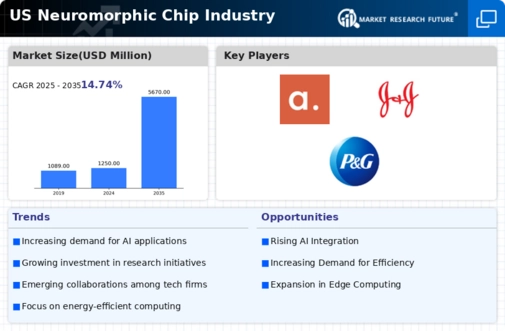The neuromorphic chip market is currently characterized by a dynamic competitive landscape, driven by advancements in artificial intelligence (AI) and machine learning technologies. Key players such as Intel (US), IBM (US), and NVIDIA (US) are at the forefront, each adopting distinct strategies to enhance their market positioning. Intel (US) focuses on innovation through its neuromorphic research initiatives, aiming to develop chips that mimic human brain functions. Meanwhile, IBM (US) emphasizes partnerships with academic institutions to foster research and development in neuromorphic computing, thereby enhancing its technological capabilities. NVIDIA (US), on the other hand, leverages its stronghold in AI graphics processing to integrate neuromorphic capabilities into its existing product lines, thus broadening its market appeal. Collectively, these strategies contribute to a competitive environment that is increasingly centered around technological innovation and collaborative efforts.
In terms of business tactics, companies are localizing manufacturing and optimizing supply chains to enhance operational efficiency. The market structure appears moderately fragmented, with several players vying for dominance. However, the influence of major companies like Intel (US) and NVIDIA (US) is substantial, as they set benchmarks for technological advancements and market trends. This competitive structure fosters an environment where smaller firms can innovate and potentially disrupt established players, leading to a vibrant market ecosystem.
In October 2025, Intel (US) announced a strategic partnership with a leading AI research institute to co-develop next-generation neuromorphic chips. This collaboration is poised to accelerate innovation in brain-inspired computing, allowing Intel (US) to leverage cutting-edge research and enhance its product offerings. The strategic importance of this partnership lies in its potential to position Intel (US) as a leader in the neuromorphic space, particularly as demand for AI-driven solutions continues to surge.
In September 2025, IBM (US) unveiled its latest neuromorphic chip, designed to improve energy efficiency by 30% compared to previous models. This development not only underscores IBM's commitment to sustainability but also enhances its competitive edge in a market increasingly focused on energy-efficient technologies. The introduction of this chip is likely to attract environmentally conscious consumers and businesses, thereby expanding IBM's market share.
In August 2025, NVIDIA (US) launched a new software platform that integrates its neuromorphic chips with existing AI frameworks, facilitating easier adoption for developers. This strategic move is significant as it lowers the barrier to entry for companies looking to implement neuromorphic technology, potentially leading to wider market acceptance. By enhancing compatibility with popular AI tools, NVIDIA (US) positions itself as a pivotal player in the neuromorphic chip market.
As of November 2025, current trends in the neuromorphic chip market are heavily influenced by digitalization, sustainability, and the integration of AI technologies. Strategic alliances among key players are shaping the competitive landscape, fostering innovation and collaboration. Looking ahead, it appears that competitive differentiation will increasingly hinge on technological advancements and supply chain reliability, rather than solely on price. This shift suggests a future where companies that prioritize innovation and sustainable practices may gain a significant advantage in the neuromorphic chip market.













Leave a Comment